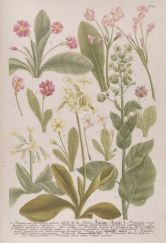Primrose Paths
By Audrey Stallsmith

Show me the steep and thorny way to heaven,
Whiles like a puffed and reckless libertine
Himself the primrose path of dalliance treads. . .
William Shakespare, Hamlet
Primroses are, strangely enough, associated with both virgins and playboys. But, then, the flower stands for inconstancy! That could be due to the fact that some primroses will soothe the skin while others, like Primula obconia, may cause an eczema-like rash when touched.
The primrose derives its name from the Old English primerole, which was probably a corruption of primavera or "first spring flower." Shakespeare calls it "the firstborn child of Ver (spring)", and the poet, Robert Herrick, dubs it "the sweet Infanta of the year."
Herrick's further description is not so flattering: "yellow-green and sickly too." The original primrose does seem to have been a wan flower, since the phrase "pale as a primrose" pops up often in old literature, usually in reference to fair young women. The flower is compared by Dobell to "a maiden looking forth/ From the window of a tower."
The drooping heroines popular in those days do not seem to have minded the comparison, however. In fact, they used water distilled from primrose and cucumber to bleach their milky complexions even whiter.
The original wild primroses were the cowslip and oxslip. The plant we now call auricula was the mountain cowslip or "bear's ears." Wild primroses have been known by a host of nicknames, including paigle, herb Peter, key flower, buckles, Mayflower, fairy cups, butter rose, or Lent rose.
In a Midsummer Night's Dream, Shakespeare writes of cowslips, "In their gold coats spots you see;/ These be rubies, fairy favours." Primroses were so associated with the "little people" that they were often considered the keys to fairyland. In 1780, John Logan wrote of the "primrose path along" which a milkmaid "sees the fairies with their queen/ Trip hand-in-hand the circled green. . ."
In fact, country folk often strewed their doorsteps with primroses on the evening before May Day to placate the pixies. Those gathering the flowerheads kept careful count, since bringing less than thirteen indoors would curse the neighborhood hens into producing only that many eggs in a year!
Primrose blooms are known as "peeps" and come in two different varieties. In the "pin-eyed," only the stigma is obvious at the center. In the "thrum-eyed," five anthers in a ring are more prominent.
A child could make a "tostie" by hanging the flower clusters across a string, then pulling it tight to force the blooms into a ball. The ancients ate primroses regularly as well: the leaves in salads and stuffings, and the flowers candied, pickled, or flavoring pottages, puddings, pies, teas, and spirits.
Cowslip wine, since it was slightly narcotic, had a reputation for banishing care. "For the future," Pope once wrote, "I'll drown all high thoughts in the Lethe (oblivion) of Cowslip Wine."
Culpeper commented, "Of the leaves of Primroses is made as fine a salve to heal wounds as any that I know." Primrose was also employed as a sedative and as a remedy for arthritis and gout.
On the darker side, the goddess Bertha is supposed to have enticed unwary children into her palace with primroses. And Webster defines the "primrose path" as that of pleasure and self-indulgence. Even more ominously, it is also described as "a course that seems easy but that leads to disaster." A character in Macbeth speaks of the "professions that go the primrose way to the everlasting bonfire."
People craving a life of ease these days are trying to find their own entrance to the primrose path. They want, like the poet, to be lulled into forgetfulness of the things that are really important.
But the Lethe he refers to was a river in Hades, the home of the dead in Greek mythology. As Ophelia knew, the "steep and thorny" road may be harder, but its destination is much to be preferred. Perhaps those primroses which sting rather than lull are doing us a favor after all!
Primroses image is from Phytanthoza Iconographia, courtesy of the Missouri Botanical Garden.








